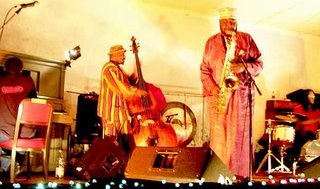
Classic meets Cuba performed at the Univ. Cultural Centre recently. It was a combination of three German classical musicians & two Cuban percussionists. Without doubt all were fine instrumentalists; the Germans: pianist, bassist & jazz drummer showed outstanding skills as soloists and the Cubans on conga & timbales were equally skillful on their own. However, when they combined, the music they produced sounded so much like old-fashioned Latin music of the fifties and sixties that it was difficult restraining a smile when the compere called it contemporary music.
One problem when trying to blend European Classical music & Latin Rhythms is that there is often inadequate fusion of the two strands; the integration is incomplete - which leads to the listener not knowing how to respond since the two traditions appear to retain their own distinctive styles more appropriate to solo recitals in their separate modes. In other words there has to be a development of listening and playing skills alongside each other for years - very much like incubating culture - before an authentic blend can emerge; it is not just an inclusion of instrumentalists from two different traditions that would produce a satisfactory blend overnight.
Apropos of this, it would be instrumental to look at the way the Bossa Nova form came into the American jazz scene via collaboration between Stan Getz, the American sax legend & Brazilian singers like Astrud Gilberto or composers like Jobim; in this case there is fusion between a Brazilian mode & the American jazz style largely thru the dominance of one - the Bossa Nova mode - & a deep structure penetration of this thru the sax interpretation that infuses the whole mode with its particular improvisional slant. Stan Getz's Mind Games Album provides a convincing illustration of the success of this blending.
Another example that springs to mind is the collaboration between Paco De Lucia the Flamenco legend & the jazz guitarists Al Di Meola & John McLaughlin in their The Guitar Trio Album; here the blend between Flamenco & jazz is seamless, largely because of the dominance of the Flamenco mode with jazz supplying supporting interpretations... In this respect the use of the electric bass (normally associated with funk or acid jazz) & African instruments like the kora in the typical Flamenco groups of the younger generation Spanish guitar bands like Ketama (Canciones Hondas) provide shining guideposts for the future of world music...
Bearing this in mind it might seem foolhardy for ethnicists to think in terms of maintaining an uncontaminated musical culture; as long as globalisation is ongoing & other cultures receive a hearing over the cyber waves, attempts at narcissistic posturing would eventually go the way of the dodo...
Sometimes, even world music would appear to be taking a step
back if basic considerations regarding technque & skill are not
given adequate attention. This appears to be the case with portions
of the recital by Femi Kuti & the Positive Force given at the
Esplanade Concert Hall on 18th March 2007. While there was an
appreciable amount spontaneity displayed by the group - especially
the three butt-wagging dancers - listening to the very simple melodic
sequences that Femi struggled to evoke from the trumpet,
saxophone & assorted instruments made it seem that the Positive
Force was teetering on the brink of being a Negative Force.
One is pleased enough that Femi is endowed with damned strong &
distinctive vocals & a fairly firm sense of social values in his
lyrics (we don't ask for more)...
NB The Japanese jazz icon Sadao Wantanabe shows the way to
world music in his performance at the Espalanade in Singapore
on 26 Nov. '07. The seventy-four year old showed that he has
not yet stopped evolving when he demonstrated how he has
integrated Senegalese percussion into his latest performance.
His percussionist is none other than N'diasse Niang - the
celebrated percussion leader from the Senegalese national
orchestra who has since settled down in Japan with his Japanese
bride. In an amazingly vibrant concert Sadao showed how African
rhythms could provide unusually energetic yet harmonically
wholesome backing for a jazzy swinging style...